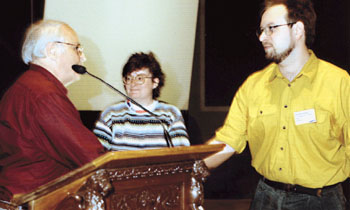
A regular feature of the nuclear physics scene is the Particles and Nuclei International Conf-erence (PANIC99), which was held in Uppsala, Sweden on 10-16 June. An appropriate symbol for the turn-of-the-millennium conference was a Swedish rune stone carved around the last millennium change and placed in front of the main building of the university.
The first such conference was held in 1963 at CERN and was organized by Victor Weisskopf, Amos de Shalit and Torleif Ericson. Five PANIC99 participants had also participated in the first meeting. The conference series was initially called High-Energy Physics and Nuclear Structure, and one of the main themes has been to link nuclear and high-energy physics. These two disciplines have become increasingly important in astrophysics and cosmology, which were given added weight in the programme of PANIC99.
The first plenary talk each day was designed to underline this cross-disciplinary character as well as to show how applications of instruments and methods are important to society. The lectures were “What quantum chromodynamics tells us about nature” (Frank Wilczek), “The theoretical enigma of gamma-ray bursts” (Martin Rees), “Charged particles in radiation medicine” (Gudrun Gotein), “Core collapse in supernovae” (Hans-Thomas Janka), “Transmutation of nuclear waste” (Waclaw Gudowski) and “Where in the world is the oscillating neutrino?” (Janet Conrad).
Wilczek was the keynote speaker and Gotein’s talk was dedicated to the late Boerje Larsson, who carried out pioneer work in radiation surgery and therapy using charged particles in Uppsala and elsewhere.
Of the 600 contributions, 200 were selected for oral presentations in the afternoon sessions, which were divided into the following topics: real and virtual photon interactions with nucleons and nuclei; meson, nucleon and hyperon interactions with nucleons and nuclei; hadron spectroscopy and structure; dense and hot matter; neutrino physics, nuclear and particle astrophysics; fundamental symmetries and the Standard Model; strong interactions in the non-perturbative region; and experimental techniques, applications and facilities for the next millennium.

Highlights in hadron and photon interactions were summarized by H Toki and A Thomas two of the convenors of the first two sessions, which were the largest in terms of number of papers. Four contributions were selected as topical talks in the morning plenary sessions. C Perdrisat presented precise data on the proton electric and magnetic form factor ratio by polarization transfer in electronproton scattering at the Jefferson Lab. K Seth reported on behalf of the E852 collaboration at Brookhaven on the discovery of new exotic mesons. J Belz talked about new measurements of direct CP violation in K decay and other recent results from Fermilab’s KteV experiment . A Gillitzer discussed the observation at GSI Darmstadt of well resolved nuclear states.
Owing to the very recent discoveries in Berkeley and Dubna of three new elements, K Aleklett commented on how they were found and their impact on research.
In addition to the morning and afternoon parallel sessions, there were poster presentations on Friday and Monday. The poster visitors could vote for the best poster presented during each of these sessions. Prizes were awarded to A Filippi for the OBELIX collaboration and J Bonn, L Bornschein, B Degen, Ch Kraus, E W Otten, H Ulrich and Ch Weinheimer from Mainz for posters on strangeness production and the OZI rule, and a study of a sensitive spectrometer for neutrino mass measurements.
The proceedings of the conference will be published in Nuclear Physics. PANIC99 showed that this type of event has an important role to play in bridging different subfields of physics, which was also underlined by the IUPAP C12 meeting. The 16th PANIC conference will be held in Japan and will be organized by the Osaka Research Centre for Nuclear Physics.
During PANIC99, CELSIUS/WASA a new detector facility to be used at the CELSIUS cooler storage ring was inaugurated at Uppsala’s Svedberg Laboratory a Swedish national facility for accelerator-based research. The new facility will be reported on in the next issue.








